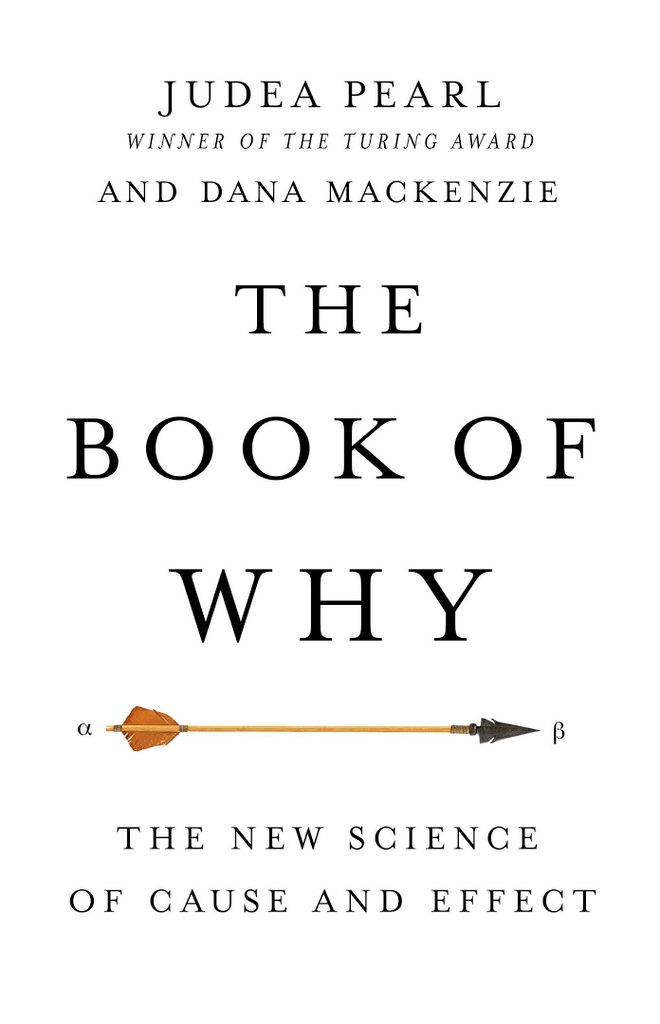因果革命: 人工智慧的大未來
| 作者 | 朱迪亞.珀爾/ 達納.麥肯錫 |
|---|---|
| 出版社 | Hachette Book Group USA |
| 商品描述 | The Book of Why: The New Science of Cause and Effect:HowthestudyofcausalityrevolutionizedscienceandtheworldCauseandeffect:it’satthecenterofscientificinquiry,a |

| 作者 | 朱迪亞.珀爾/ 達納.麥肯錫 |
|---|---|
| 出版社 | Hachette Book Group USA |
| 商品描述 | The Book of Why: The New Science of Cause and Effect:HowthestudyofcausalityrevolutionizedscienceandtheworldCauseandeffect:it’satthecenterofscientificinquiry,a |
內容簡介 電腦科學界諾貝爾獎「圖靈獎」得主暨貝氏網路研發先驅Judea Pearl總結畢生研究成果,聯手獲獎的統計學家Dana Mackenzie,提出改變人工智慧及科學界的重要工具! ▎大數據看似厲害,其實有很大的侷限 近幾年大數據當紅,加上它在許多領域的成功運用,其地位與能力備受追捧。與大數據密切相關的統計學,是法蘭西斯・高爾頓與卡爾・皮爾森解答對於遺傳的疑問未果,而開發出來的學科,這門學科創立後興盛數十載,其名言「相關不是因果」影響科學界經常止步於探究「關聯」而非「因果」,並且長期受資料本位的歷史所影響,認為資料無所不能,但是朱迪亞・珀爾希望藉此書告訴讀者,資料本身一點也不智慧。 ▎要發展出「強AI」,機率思考仍遠遠不夠 一九八○年代初,朱迪亞・珀爾認為不確定性是AI所欠缺的最重要的能力,於是運用機率開發出強大的推理工具——貝氏網路,因而獲得有電腦科學界諾貝爾獎之稱的「圖靈獎」。貝氏網路是首先讓電腦以灰階方式思考的工具,至今仍極受人工智慧界倚重,然而到了一九八○年代末,珀爾認為貝氏網路仍沒有填補人工智慧和人類智慧的差距,於是他轉而研究如何教AI學會「因果推論」,本書便是整理了歷代科學家推展因果革命的努力與成果。 ▎從「求得相關性」的舊階段,邁入「釐清因果關係」的新時代 本書最初幾章是有趣的科學史,探討科學家追求因果解釋的過程如何受挫,以致發展出統計學,並讓統計學方法長期引領學界研究。接著書中有大約一半篇幅,作者以實例示範因果語言(圖示模型)如何解決傳統統計學認為無解的難題,逐一揭示「因果階梯」三大分層的能力(越高的層級,認知挑戰越高,越難理出因果關係),並讓讀者了解因果革命路上諸人的努力與進展,以及這些進展的重要性。本書末尾回頭說明因果革命相對於人工智慧各重要發展面向(比如大數據、深度學習、資料探勘、機器學習等),有何勝出之處、能對它們起什麼正面影響,以及最重要的——「因果革命」將會如何改變人工智慧。 ▎「因果革命」不只影響人工智慧,還影響各研究領域 現今機器學習運作時仰賴的是「相關性」,而不是「因果」,如果能成功將因果思考導入電腦,將使電腦變成真正的科學家,使它們成為我們的得力伙伴,提供我們更合理的洞見。由於因果思考可以呈現罪責,電腦能因而具備道德感——「具備道德感的強AI」是因果革命在人工智慧領域的終極追求,作者形容這「是人工智慧給人類的第一個、也是最好的禮物」。 因果性研究還釐清了我們多年來對許多知識本質的不解,改變我們對於眾多問題的認識,這些問題牽涉的層面無所不包,舉凡涉及解讀資料以及根據解釋而採取的作法(像是致病因素、醫療資源分配、公共政策擬定等),都能受益。集結眾多領域學人之力才有如今成果的因果革命,亦將回頭影響整個科學界,珀爾形容它「將使科學的體質更加健全,是人工智慧給人類的第二個禮物」。在美國,因果科學已經開始被大學列入課程…… ▎我們強烈建議這些人士閱讀這本書: (1)資料科學家與大數據研究者,以及對大數據深感興趣的人 (2)統計學家、數學家,電腦科學相關從業人員與學習者 (3)對經濟趨勢與科研發展有興趣的一般大眾 (4)希望培養科學素養,了解最新科學方法的學子 本中文書介出自<<因果革命: 人工智慧的大未來>> 行路出版 How the study of causality revolutionized science and the world Cause and effect: it’s at the center of scientific inquiry, and yet for decades scientists had no way of answering simple questions, such as whether smoking causes cancer. In The Book of Why, Judea Pearl and Dana Mackenzie show how Pearl's work on causality has broken through this stalemate, unleashing a revolution in our knowledge of the world. Anyone who wants to understand how science, the human mind, or artificial intelligence works needs The Book of Why. “Illuminating. . . a valuable lesson on the history of ideas.” —New York Times “This book really gets you thinking about cause and effect as it applies to issues of our time. . . . Extraordinary.” —Science Friday
各界推薦 "Illuminating... The Professor Pearl who emerges from the pages of The Book of Why brims with the joy of discovery and pride in his students and colleagues... [it] not only delivers a valuable lesson on the history of ideas but provides the conceptual tools needed to judge just what big data can and cannot deliver."—New York Times "Cause and effect is one of the most heavily debated, difficult-to-prove things in science and medicine. This book really gets you thinking about cause and effect as it applies to issues of our time, such as: How come cigarettes were around for years and we never showed they were causing cancer or heart disease? The authors goes through these cases like an interrogation, and it's just extraordinary."—Science Friday
作者介紹 Judea PearlJudea Pearl is a professor of computer science at UCLA. The author of three books, he has won numerous awards, including the Alan Turing Award. He lives in Los Angeles, California.Dana MackenzieDana Mackenzie is a PhD mathematician turned science writer and has written for Science, New Scientist, and Scientific American, among others. He lives in Santa Cruz, California.
| 書名 / | The Book of Why: The New Science of Cause and Effect |
|---|---|
| 作者 / | 朱迪亞.珀爾 達納.麥肯錫 |
| 簡介 / | The Book of Why: The New Science of Cause and Effect:HowthestudyofcausalityrevolutionizedscienceandtheworldCauseandeffect:it’satthecenterofscientificinquiry,a |
| 出版社 / | Hachette Book Group USA |
| ISBN13 / | 9781541698963 |
| ISBN10 / | 1541698967 |
| EAN / | 9781541698963 |
| 誠品26碼 / | 2681804626009 |
| 頁數 / | 512 |
| 注音版 / | 否 |
| 裝訂 / | P:平裝 |
| 語言 / | 3:英文 |
| 尺寸 / | 23X16X0CM |
| 級別 / | N:無 |
| 重量(g) / | 498.9 |
自序 : ALMOST two decades ago, when I wrote the preface to my book Causality (2000), I made a rather daring remark that friends advised me to tone down. “Causality has undergone a major transformation,” I wrote, “from a concept shrouded in mystery into a mathematical object with well-defined semantics and well-founded logic. Paradoxes and controversies have been resolved, slippery concepts have been explicated, and practical problems relying on causal information that long were regarded as either metaphysical or unmanageable can now be solved using elementary mathematics. Put simply, causality has been mathematized.”
Reading this passage today, I feel I was somewhat shortsighted. What I described as a “transformation” turned out to be a “revolution” that has changed the thinking in many of the sciences. Many now call it “the Causal Revolution,” and the excitement that it has generated in research circles is spilling over to education and applications. I believe the time is ripe to share it with a broader audience.
This book strives to fulfill a three-pronged mission: first, to lay before you in nonmathematical language the intellectual content of the Causal Revolution and how it is affecting our lives as well as our future; second, to share with you some of the heroic journeys, both successful and failed, that scientists have embarked on when confronted by critical cause-effect questions.
Finally, returning the Causal Revolution to its womb in artificial intelligence, I aim to describe to you how robots can be constructed that learn to communicate in our mother tongue—the language of cause and effect. This new generation of robots should explain to us why things happened, why they responded the way they did, and why nature operates one way and not another. More ambitiously, they should also teach us about ourselves: why our mind clicks the way it does and what it means to think rationally about cause and effect, credit and regret, intent and responsibility.
When I write equations, I have a very clear idea of who my readers are. Not so when I write for the general public—an entirely new adventure for me. Strange, but this new experience has been one of the most rewarding educational trips of my life. The need to shape ideas in your language, to guess your background, your questions, and your reactions, did more to sharpen my understanding of causality than all the equations I have written prior to writing this book.
For this I will forever be grateful to you. I hope you are as excited as I am to see the results.
Judea Pearl
Los Angeles, October 2017